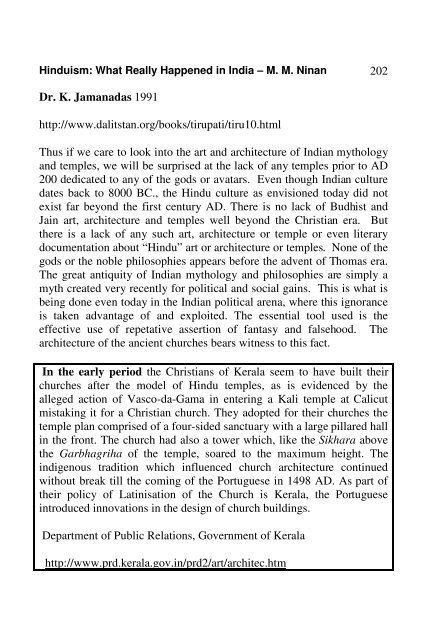You also want an ePaper? Increase the reach of your titles
YUMPU automatically turns print PDFs into web optimized ePapers that Google loves.
<strong>Hinduism</strong>: What Really Happened in India – M. M. Ninan 202<br />
Dr. K. Jamanadas 1991<br />
http://www.dalitstan.org/books/tirupati/tiru10.html<br />
Thus if we care to look into the art and architecture of Indian mythology<br />
and temples, we will be surprised at the lack of any temples prior to AD<br />
200 dedicated to any of the gods or avatars. Even though Indian culture<br />
dates back to 8000 BC., the Hindu culture as envisioned today did not<br />
exist far beyond the first century AD. There is no lack of Budhist and<br />
Jain art, architecture and temples well beyond the <strong>Christian</strong> era. But<br />
there is a lack of any such art, architecture or temple or even literary<br />
documentation about “Hindu” art or architecture or temples. None of the<br />
gods or the noble philosophies appears before the advent of Thomas era.<br />
The great antiquity of Indian mythology and philosophies are simply a<br />
myth created very recently for political and social gains. This is what is<br />
being done even today in the Indian political arena, where this ignorance<br />
is taken advantage of and exploited. The essential tool used is the<br />
effective use of repetative assertion of fantasy and falsehood. The<br />
architecture of the ancient churches bears witness to this fact.<br />
In the early period the <strong>Christian</strong>s of Kerala seem to have built their<br />
churches after the model of Hindu temples, as is evidenced by the<br />
alleged action of Vasco-da-Gama in entering a Kali temple at Calicut<br />
mistaking it for a <strong>Christian</strong> church. They adopted for their churches the<br />
temple plan comprised of a four-sided sanctuary with a large pillared hall<br />
in the front. The church had also a tower which, like the Sikhara above<br />
the Garbhagriha of the temple, soared to the maximum height. The<br />
indigenous tradition which influenced church architecture continued<br />
without break till the coming of the Portuguese in 1498 AD. As part of<br />
their policy of Latinisation of the Church is Kerala, the Portuguese<br />
introduced innovations in the design of church buildings.<br />
Department of Public Relations, Government of Kerala<br />
http://www.prd.kerala.gov.in/prd2/art/architec.htm


















